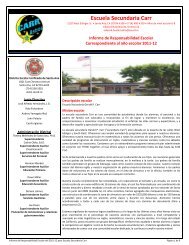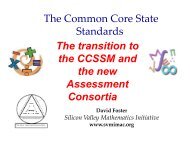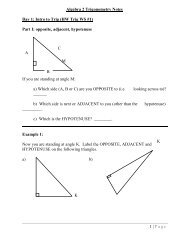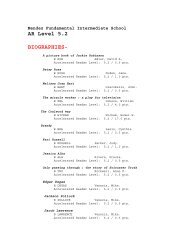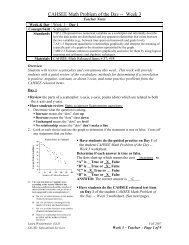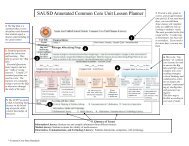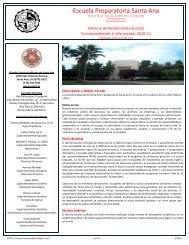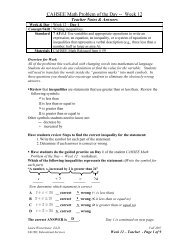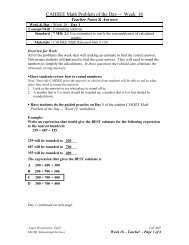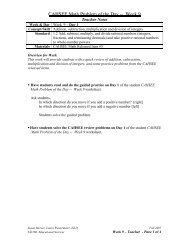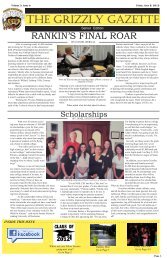Lathrop Intermediate School - Santa Ana Unified School District
Lathrop Intermediate School - Santa Ana Unified School District
Lathrop Intermediate School - Santa Ana Unified School District
You also want an ePaper? Increase the reach of your titles
YUMPU automatically turns print PDFs into web optimized ePapers that Google loves.
<strong>Lathrop</strong> <strong>Intermediate</strong> <strong>School</strong>1111 South Broadway • <strong>Santa</strong> <strong>Ana</strong>, CA 92707-1205 • (714) 567-3300 • Grades 6-8Adrian Ayala, Principaladrian.ayala@sausd.us---- ----2011-12 <strong>School</strong> Accountability Report CardPublished During the 2012-13 <strong>School</strong> Year<strong>Santa</strong> <strong>Ana</strong> <strong>Unified</strong> <strong>School</strong> <strong>District</strong>1601 East Chestnut Avenue<strong>Santa</strong> <strong>Ana</strong>, CA 92701-6322(714) 558-5501www.sausd.us<strong>District</strong> Governing BoardJosé Alfredo Hernández, J.D.Rob RichardsonAudrey Yamagata-NojiJohn PalacioCecilia Iglesias<strong>District</strong> AdministrationThelma Meléndez de <strong>Santa</strong> <strong>Ana</strong>, Ph.D.SuperintendentCathie Olsky, Ed.D.Deputy SuperintendentChad HammittAssistant SuperintendentPersonnel ServicesHerman MendezAssistant SuperintendentElementary EducationDawn MillerAssistant SuperintendentSecondary EducationDoreen LohnesAssistant SuperintendentSupport ServicesJoe DixonAssistant SuperintendentFacilities Planning &Governmental Relations<strong>School</strong> DescriptionJulia C. <strong>Lathrop</strong> <strong>Intermediate</strong> <strong>School</strong> is located at the corner of S. Broadway and W.McFadden Ave.For the 2012-2013 school year <strong>Lathrop</strong> <strong>Intermediate</strong> <strong>School</strong> students will participate in a sixperiod day. All students will have one period of mathematics, English language arts, science,social science and physical education. In addition, all <strong>Lathrop</strong> <strong>Intermediate</strong> <strong>School</strong> studentswill have one period of an elective. The elective program will consist of Art, Technology,Multimedia/Digital Art, AVID, MESA, Spanish, Yearbook, Leadership, PAL (Peer AssistantLeadership), Choir, Band, Orchestra, and English Intervention (Read 180), Math Intervention(Mind Institute). Additionally, 4 days a week, <strong>Lathrop</strong> students participate in a CollegePreparation "Seminar" period lasting 12 minutes and dealing with study skills, characterbuilding and being a successful student. Students are assigned to the same College Prepteacher for the 3 years they attened <strong>Lathrop</strong>.Parental involvement and parent education is focused on the development of awareness andunderstanding of the educational processes. All parents activities are designed to establishtransparent, credible processes for community and stakeholder involvement. <strong>School</strong> SiteCouncil (SSC) and the English Learners Advisory Committee (ELAC) emphasize parent decisionmaking at the site and district level. <strong>Lathrop</strong> is well represented at the DEC/DELAC ,Superintendent's forums and at the annual district wide parent conference.Over the last three school years, <strong>Lathrop</strong> has demonstrated improvement on the CaliforniaStandards Tests in English Language Arts and Mathematics, as measured by the AcademicPerformance Index which has grown from 611 to 685 points. <strong>School</strong>-wide proficiency hasincreased from 24% to 31% proficient in English and from 29% to 37% in Mathematics. Inschool year 2011-12, <strong>Lathrop</strong> gained 37 points on API. The staff of <strong>Lathrop</strong> <strong>Intermediate</strong><strong>School</strong> is committed to working diligently to engage our students in learning to increaseEnglish, Math, Social Science and Science proficiency for all students.<strong>School</strong> Mission:<strong>Lathrop</strong> <strong>Intermediate</strong> <strong>School</strong> is dedicated to educational excellence. Provided with a rigorous,standards based curriculum, students are enabled to construct the academic andtechnological skills necessary for success in high school, college and career.2011-12 <strong>School</strong> Accountability Report Card for <strong>Lathrop</strong> <strong>Intermediate</strong> <strong>School</strong> Page 1 of 9
<strong>District</strong> Profile<strong>Santa</strong> <strong>Ana</strong> <strong>Unified</strong> <strong>School</strong> <strong>District</strong> is the seventh largest district in the state, currently servicing over 57,000 students in grades K-12 and residing in thecity of <strong>Santa</strong> <strong>Ana</strong>. The district currently operates 36 elementary schools, 9 intermediate schools, 7 high schools, 1 alternative high school, 2continuation schools and 5 charter schools. The student population is comprised of approximately 77.8% enrolled in the Free or Reduced Price Mealprogram, 51.3% qualifying for English language learner support, and approximately 9.0% receiving special education services. Our district’s schoolshave received California Distinguished <strong>School</strong>s, National Blue Ribbon <strong>School</strong>s, California Model <strong>School</strong>, Title I Academic Achieving <strong>School</strong>s andGovernor’s Higher Expectations awards in honor of their outstanding school programs. Over 25 schools have received the Golden Bell Award.Each of <strong>Santa</strong> <strong>Ana</strong> <strong>Unified</strong> <strong>School</strong> <strong>District</strong>’s staff members, parents, and community partners have developed and maintained high expectations toensure every student’s intellectual, creative, physical, emotional, and social development needs are met. The district’s commitment to excellence isachieved through a team of professionals dedicated to delivering a challenging, high quality educational program. Consistent success in meetingstudent performance goals is directly attributed to the district’s energetic teaching staff and strong parent and community support.<strong>District</strong> MissionWe assure well-rounded learning experiences, which prepare our students for success in college and career. We engage, inspire, and challenge all ofour students to become productive citizens, ethical leaders, and positive contributors to our community, country and a global society.<strong>District</strong> VisionWe will work collaboratively and comprehensively with staff, parents, and the community to strengthen a learning environment focused on raising theachievement of all students and preparing them for success in college and career.Opportunities for Parental InvolvementParents are encouraged to get involved in <strong>Lathrop</strong> <strong>Intermediate</strong> <strong>School</strong>'s learning community by volunteering their time, attendingschool events, or sharing in the decision-making process. The school welcomes assistance in the classroom, parent center, library andmedia center. Parents are always invited to help chaperon field trips, dances or any other school events. <strong>Lathrop</strong> <strong>Intermediate</strong> <strong>School</strong>provides a wide range of opportunities for parents to interact with school staff while supporting their child's academic efforts; thesemay include:• Program Verification / Parent Inservice• Back to <strong>School</strong> Night/Open House• Classroom visits• Student performances• Music/choir and/or theatre performances• Science fairs• Sports events• Promotion activities• Student recognition assemblies• Parent education training and/or workshopsThe following campus organizations provide opportunities for parents to have input on curricular programs, activities, and the design ofthe <strong>School</strong>’s Plan:• <strong>School</strong> Site Council• English Learners Advisory Committee• Parent Teacher Organization (PTO)Parents seeking more information about becoming an active member in the school community may contact the principal or assistantprincipal at (714) 567-3300.<strong>School</strong>-to-home communication is provided in both English and Spanish. Through routine correspondence and special announcements,parents are kept informed on school news, student activities, schedules, policy changes, and class curriculum updates including thefollowing formats:• Edulink System / Teleparent• <strong>School</strong> web site• Public Service Channel 31 or 51• Flyers• Letters• <strong>School</strong> Marquee/Banners• New Student Orientations2011-12 <strong>School</strong> Accountability Report Card for <strong>Lathrop</strong> <strong>Intermediate</strong> <strong>School</strong> Page 2 of 9
About the SARCEvery school in California is required by state law to publish a <strong>School</strong> Accountability Report Card (SARC), by February 1 of each year. TheSARC contains information about the condition and performance of each California public school. All data are reported for the 2011-12school-year, unless otherwise indicated. For more information about SARC requirements, see the California Department of Education(CDE) SARC webpage at www.cde.ca.gov/ta/ac/sa/. For additional information about this school, please contact the schooladministration at (714) 567-3300.Grade LevelStudent Enrollment by Grade LevelNumber of StudentsGr. 6-- 363Gr. 7-- 411Gr. 8-- 408Total-- 1,182GroupStudent Enrollment by GroupPercent of Total EnrollmentBlack or African American------- 0.1American Indian or Alaska Native---0----Asian------- 0.6Filipino------- 0Hispanic or Latino------- 98.9Native Hawaiian/Pacific Islander 0.1White 0.3Two or More Races 0Socioeconomically Disadvantaged 92.4English Learners 59.4Students with Disabilities 11.8Average Class Size and Class Size DistributionAverage Class SizeNumber of Classrooms*1-20 21-32 33+Year 10 11 12 10 11 12 10 11 12 10 11 12English 21.36 26.1 22.9 124 15 27 135 42 47 19 12 0Math--- 25.66 28.7 20.4 18 4 21 99 16 21 6 9 0Science 24.94 29.1 23.6 19 4 7 88 16 27 2 9 0SS----- 28.07 27.1 23.6 11 4 8 61 20 26 26 7 0* Number of classes indicates how many classrooms fall into each size category(a range of total students per classroom). At the secondary school level, thisinformation is reported by subject area, English, Math, Science and SocialScience (SS), rather than grade level.Suspensions and Expulsions<strong>School</strong> 09-10 10-11 11-12Suspensions Rate 26.91 28.81 34.92Expulsions Rate 0.14 0.54 0.34<strong>District</strong> 09-10 10-11 11-12Suspensions Rate 12.11 10.14 14.5Expulsions Rate 0.34 0.25 0.51* The rate of suspensions and expulsions is calculated by dividing the totalnumber of incidents by the total enrollment (and multiplying by 100).<strong>School</strong> Safety PlanThis section provides information about the school’s comprehensive safety plan, including the dates on which the safety plan was last reviewed,updated, and discussed with faculty; as well as a brief description of the key elements of the plan.The Comprehensive <strong>School</strong> Site Safety Plan was developed in collaboration with local agencies and the district office to fulfill Senate Bill 187requirements. Components of this plan include child abuse reporting procedures, teacher notification of dangerous pupil procedures, disaster responseprocedures, procedures for safe arrival and departure from school, sexual harassment policy, and dress code policy. The school’s most current safetyplan was reviewed and updated to address the safety plan components and individual responsibilities during the 2011-2012 school year. The <strong>Santa</strong> <strong>Ana</strong><strong>Unified</strong> <strong>School</strong> <strong>District</strong>’s Board of Trustees reviews the safety plans annually by March 1.<strong>School</strong> Facility Conditions and Planned Improvements (<strong>School</strong> Year 2012-13)This section provides information from the most recent Facility Inspection Tool (FIT) data (or equivalent), including:• Description of the safety, cleanliness, and adequacy of the school facility• Description of any planned or recently completed facility improvements• The year and month in which the data were collected• Description of any needed maintenance to ensure good repairYear and month in which data were collected: 06/21/12<strong>School</strong> custodial staff and the district’s maintenance department work together to ensure classrooms and campus grounds are well-maintained andkept safe and functioning for students, staff, and visitors. Maintenance and Operations (M&O) employs an electronic work order system enablingschool staff to communicate unscheduled maintenance needs, urgent repairs, or special projects. Most of the school's repairs and maintenanceprojects are performed by the district’s highly qualified, professional trade specialists. Emergency situations are immediately resolved either by theschool custodian or district maintenance staff, based upon the nature of the situation.Day and evening custodians work closely as a team and with the principal for routine maintenance, daily custodial duties, and special eventspreparations. The principal and day custodian communicate daily to discuss campus cleaning needs and safety concerns. Every morning before schoolbegins, the custodian, principal, and assistant principal inspect facilities for safety hazards, graffiti, and other conditions that require removal prior tostudents and staff entering school grounds.2011-12 <strong>School</strong> Accountability Report Card for <strong>Lathrop</strong> <strong>Intermediate</strong> <strong>School</strong> Page 3 of 9
<strong>School</strong> safety and cleanliness are the custodians’ highest priority and strongly emphasized as a component of their daily routines. Custodians aretrained by M&O’s administrators on proper cleaning procedures, use of chemicals, and use of equipment. The day custodians are responsible forfollowing an established set of cleaning standards and prioritization procedures for general campus maintenance. The day custodian checks restroomstwice a day as a proactive measure in keeping facilities well stocked, safe, and sanitary. The evening custodians are responsible for thorough cleaningof classrooms, office areas, and restrooms. Groundskeepers are dispatched by the district office to perform general maintenance of landscaping,gardening, sports fields, and irrigation systems.The most recent facilities inspection at <strong>Lathrop</strong> <strong>Intermediate</strong> <strong>School</strong> took place on 06/21/12. <strong>School</strong>s are required by state law to reportthe condition of their facilities; the <strong>School</strong> Site Inspection table illustrated in this report identifies the state required inspection areasand discloses the operational status in each of those areas.<strong>School</strong> Facility Good Repair Status (<strong>School</strong> Year 2012-13)This section provides information from the most recent Facility Inspection Tool (FIT) data (or equivalent), including:• Determination of repair status for systems listed• Description of any needed maintenance to ensure good repair• The Overall Rating (bottom row)System InspectedSystems:Gas Leaks, Mechanical/HVAC, SewerInterior:Interior SurfacesCleanliness:Overall Cleanliness, Pest/ Vermin Infestation<strong>School</strong> Facility Good Repair StatusRepair StatusExemplary Good Fair Poor[ ] [X] [ ] [ ][ ] [X] [ ] [ ]Repair Needed andAction Taken or Planned[ ] [X] [ ] [ ] Carpet repair room 203, 204, 206, 103,111.Service call # 200794Electrical:ElectricalRestrooms/Fountains:Restrooms, Sinks/ FountainsSafety:Fire Safety, Hazardous MaterialsStructural:Structural Damage, RoofsExternal:Playground/<strong>School</strong> Grounds, Windows/Doors/Gates/Fences[ ] [X] [ ] [ ][ ] [X] [ ] [ ][ ] [X] [ ] [ ][ ] [X] [ ] [ ][ ] [X] [ ] [ ]Overall Rating [X] [ ] [ ] [ ]Teacher Credentials<strong>School</strong> 09-10 10-11 11-12Fully Credentialed 56 54 52Without Full Credential 0 0 0Teaching Outside Subject Area 0 0 0<strong>District</strong>wide 09-10 10-11 11-12Fully Credentialed ♦ ♦ 2,013Without Full Credential ♦ ♦ 81Teacher Misassignments and Vacant Teacher Positions at this <strong>School</strong><strong>School</strong> 10-11 11-12 12-13Teachers of English Learners 0 0 0Total Teacher Misassignments 0 0 0Vacant Teacher Positions 1 0 0* “Misassignments” refers to the number of positions filled by teachers wholack legal authorization to teach that grade level, subject area, student group,etc.2011-12 <strong>School</strong> Accountability Report Card for <strong>Lathrop</strong> <strong>Intermediate</strong> <strong>School</strong> Page 4 of 9
Professional DevelopmentThis section provides information on the number of days provided for professional development and continuous professional growth in the mostrecent three year period.All curriculum and instructional improvement activities at <strong>Santa</strong> <strong>Ana</strong> <strong>Unified</strong> <strong>School</strong> <strong>District</strong> are aligned to the California State Content Standards andFrameworks. Staff development concentrations are selected and identified based upon student assessment results, NCLB requirements, teacher input,state content standards, and professional development surveys.All staff development activities at <strong>Santa</strong> <strong>Ana</strong> <strong>Unified</strong> <strong>School</strong> <strong>District</strong> are focused on increasing student learning and proficiency. During the 2011-2012school year, our school sponsored three days of staff development. Staff training topics at the individual school sites included: Thinking Maps, PositiveBehavior Interventions Support , effective student engagement practices, lesson planning, and effective teaching strategies.<strong>Santa</strong> <strong>Ana</strong> <strong>Unified</strong> <strong>School</strong> <strong>District</strong> offers supplemental training and support for new and ongoing program implementation. Training activities take placethroughout the school year, after school, and during the summer and generally focus on curriculum, teaching strategies, and methodologies. Duringthe 2011-2012 school year, district training opportunities focused on the following:At the secondary level –• Language Arts• SDAIE Training (Specially Designed Academic Instruction In English)• AVID Training (Advancement Via Individual Determination)• CTAP Technology Training (California Technology Assistance Project)• Working with Parents• GATE Training (Gifted And Talented Education)• GLAD Training (Guided Language Acquisition Design)• Special Education• Data <strong>Ana</strong>lysis and Using Data to Drive Instruction• Curriculum Mapping• Pivot Coaching for Instructional leadersNew teachers and teachers not yet fully credentialed are supported by peer coaching and extensive staff development. The BTSA Induction Program(Beginning Teacher Support and Assistance) is a state-approved program that offers additional support and assistance to newly credentialed teachers.All new teachers are assigned to a Support Provider (mentor teacher) and provided individualized support over a two-year period. More informationabout the BTSA Induction Program is available at http://www.sausd.us/14431028114350867/site/default.aspTo support tenured teachers as well as new teachers to the district, <strong>Santa</strong> <strong>Ana</strong> <strong>Unified</strong> <strong>School</strong> <strong>District</strong> offers Peer Assistance and Review (PAR) which iseasily defined as teachers helping teachers. Experienced and knowledgeable veteran teachers, referred to as Consulting Teachers, provide ongoingassistance to teachers who need to improve their instructional skills, classroom management strategies, subject knowledge, and/or related aspects oftheir teaching performance.Staff members are encouraged to attend professional workshops and conferences. New teachers, experienced teachers, mentor/ teacher leaders,administrators, and support staff are encouraged to participate in workshops sponsored by the Orange County Office of Education and courses offeredby community colleges and universities. Classified support staff may receive additional job-related training from vendors, department supervisors, anddistrict representatives.2011-12 <strong>School</strong> Accountability Report Card for <strong>Lathrop</strong> <strong>Intermediate</strong> <strong>School</strong> Page 5 of 9
Core Academic Classes Taught by Highly Qualified TeachersThe Federal Elementary and Secondary Education Act (ESEA), also knownas No Child Left Behind (NCLB), requires that core academic subjects betaught by Highly Qualified Teachers, defined as having at least abachelor’s degree, an appropriate California teaching credential, anddemonstrated core academic subject area competence. For moreinformation, see the CDE Improving Teacher and Principal Qualitywebpage at: www.cde.ca.gov/nclb/sr/tq/Percent of Classes In Core Academic SubjectsCore Academic Classes Taught by Highly Qualified TeachersLocation of ClassesTaught by HighlyQualified TeachersNot Taught by HighlyQualified TeachersThis <strong>School</strong> 100 0<strong>District</strong>wideAll <strong>School</strong>s 99.72 0.28High-Poverty <strong>School</strong>s 99.72 0.28Low-Poverty <strong>School</strong>s 0 0* High-poverty schools are defined as those schools with student eligibility ofapproximately 40 percent or more in the free and reduced price mealsprogram. Low-poverty schools are those with student eligibility ofapproximately 25 percent or less in the free and reduced price mealsprogram.Academic Counselors and Other Support Staff at this <strong>School</strong>Number of Full-Time Equivalent (FTE)Academic Counselor------- 2Social/Behavioral or Career Development CounselorLibrary Media Teacher (Librarian) 0Library Media Services Staff (Paraprofessional)Psychologist------- 0Social Worker------- 0Nurse------- 0Speech/Language/Hearing Specialist 0Resource Specialist------- 0Other------- 0Average Number of Students per Staff MemberAcademic Counselor------- 418* One Full-Time Equivalent (FTE) equals one staff member working full-time;one FTE could also represent two staff members who each work 50 percentof full-time.LevelExpenditures Per Pupil and <strong>School</strong> Site Teacher Salaries(Fiscal Year 2010-11)Expenditures Per PupilTotal Restricted UnrestrictedAverageTeacherSalary<strong>School</strong> Site- $6,374 $3,137 $3,238 $72,147<strong>District</strong>------ ♦ ♦ $4,101 $80,860- State------- ♦ ♦ $5,455 $68,835Percent Difference: <strong>School</strong> Site/<strong>District</strong> -21.1% -10.8%Percent Difference: <strong>School</strong> Site/ State -40.7% 4.8%* Supplemental/Restricted expenditures come from money whose use iscontrolled by law or by a donor. Money that is designated for specificpurposes by the district or governing board is not considered restricted.* Basic/Unrestricted expenditures are from money whose use, except forgeneral guidelines, is not controlled by law or by a donor.For detailed information on school expenditures for all districts inCalifornia, see the CDE Current Expense of Education & Per-pupilSpending webpage at www.cde.ca.gov/ds/fd/ec/. For information onteacher salaries for all districts in California, see the CDE CertificatedSalaries & Benefits webpage at www.cde.ca.gov/ds/fd/cs/. To look upexpenditures and salaries for a specific school district, see the Ed-DataWeb site at: www.ed-data.org.Teacher and Administrative Salaries (Fiscal Year 2010-11)Category<strong>District</strong>AmountState Average for<strong>District</strong>s In SameCategoryBeginning Teacher Salary $48,660 $41,455Mid-Range Teacher Salary $74,308 $66,043Highest Teacher Salary $94,284 $85,397Average Principal Salary (ES) $112,475 $106,714Average Principal Salary (MS) $112,695 $111,101Average Principal Salary (HS) $124,829 $121,754Superintendent Salary $241,718 $223,357Percent of <strong>District</strong> BudgetTeacher Salaries 41% 39%Administrative Salaries 4% 5%* For detailed information on salaries, see the CDE Certificated Salaries &Benefits webpage at www.cde.ca.gov/ds/fd/cs/.2011-12 <strong>School</strong> Accountability Report Card for <strong>Lathrop</strong> <strong>Intermediate</strong> <strong>School</strong> Page 6 of 9
Types of Services Funded (Fiscal Year 2011-12)This section provides specific information about the types of programs and services available at the school that support and assists students. Forexample, this narrative may include information about supplemental educational services related to the school’s federal Program Improvement (PI)status.In addition to general fund state funding, <strong>Santa</strong> <strong>Ana</strong> <strong>Unified</strong> <strong>School</strong> <strong>District</strong> receives state and federal categorical funding for special programs. For the2011-12 school year, the <strong>District</strong> received approximately $3,769 per student in federal, state, and local aid for categorical, special education, andsupport programs, including but not limited to:• Bilingual Education• Beginning Teacher & Support (BTSA)• California Child Nutrition Education• Carl Perkins• Class Size Reduction• Comprehensive <strong>School</strong> Reform• Drug Free <strong>School</strong>s• Even Start Family Literacy• Gifted & Talented Education• Head Start• Instructional Materials• Migrant Education• Peer Assistance & Review• Regional Occupational Program• Safe <strong>School</strong>s and Healthy Students• Special Education• Title I, II, III, IV, & VII• Vocational Education• Reading FirstQuality, Currency, Availability of Textbooks and Instructional Materials (<strong>School</strong> Year 2012-13)This section describes whether the textbooks and instructional materials used at the school are from the most recent adoption; whether there aresufficient textbooks and instruction materials for each student; and information about the school’s use of any supplemental curriculum or non-adoptedtextbooks or instructional materials.Year and month in which data were collected: October 9, 2012All textbooks used in the core curriculum throughout <strong>Santa</strong> <strong>Ana</strong> <strong>Unified</strong> <strong>School</strong> <strong>District</strong> are aligned to the California Content Standards andFrameworks. Instructional materials for grades K-8 are selected from the state’s most recent list of standards-based materials and adopted by the StateBoard of Education. Instructional materials for grades 9-12 are standards based and approved by the district’s Board of Trustees. On October 9, 2012,the <strong>Santa</strong> <strong>Ana</strong> <strong>Unified</strong> <strong>School</strong> <strong>District</strong>’s Board of Trustees held a public hearing to certify the extent to which textbooks and instructional materials havebeen provided to students. The Board of Trustees adopted Resolution No 12/13-2940 which certifies as required by Education Code §60119 that forthe 2012-2013 school year, the <strong>Santa</strong> <strong>Ana</strong> <strong>Unified</strong> <strong>School</strong> <strong>District</strong> has provided sufficient textbooks or instructional materials, or both, that areconsistent with the content and cycles of the curriculum frameworks adopted by the State Board, to each pupil enrolled in a foreign language or healthcourse, and that sufficient laboratory science equipment applicable to science laboratory courses offered in grades 9-12, inclusive, is available to pupils.Year Adopted <strong>Intermediate</strong> <strong>School</strong> Textbook Publisher GradesMathematics2008 CGP Education, California Mathematics 62008 CGP Education, California Mathematics 72008 Holt, Rinehart, Winston, Holt California Algebra Readiness 82008 College Preparatory Mathematics, California Algebra Connections 8Language Arts2009 Hampton Brown, Inside Language (A-G)) 6-82002 Holt, Rinehart, Winston 6-8Science(s)2007 Holt, Rinehart, Winston, Earth Science 62007 Holt, Rinehart, Winston, Life Science 72007 Holt, Rinehart, Winston, Physical 8Social Science2006 Pearson/Prentice-Hall, Ancient Civilization 62006 Pearson/Prentice-Hall, Medieval & Early Modern Times 72006 Glencoe/McGraw Hill, Discovering our past: The American Journey to WWI 82011-12 <strong>School</strong> Accountability Report Card for <strong>Lathrop</strong> <strong>Intermediate</strong> <strong>School</strong> Page 7 of 9
Note: Scores are not shown when the number of students tested is ten orless, either because the number of students in this category is too smallfor statistical accuracy or to protect student privacy.The Standardized Testing and Reporting (STAR) Program consists ofseveral key components, including:• California Standards Tests (CSTs), which include Englishlanguagearts (ELA) and mathematics (Math) in grades two througheleven; science in grades five, eight, and nine through eleven; andhistory-social science (H-SS) in grades eight, and nine througheleven.• California Modified Assessment (CMA), an alternateassessment that is based on modified achievement standards in ELAfor grades three through eleven; mathematics for grades threethrough seven, Algebra I, and Geometry; and science in grades fiveand eight, and Life Science in grade ten. The CMA is designed toassess those students whose disabilities preclude them fromachieving grade-level proficiency on an assessment of the Californiacontent standards with or without accommodations.• California Alternate Performance Assessment (CAPA),includes ELA and mathematics in grades two through eleven, andscience for grades five, eight, and ten. The CAPA is given to thosestudents with significant cognitive disabilities whose disabilitiesprevent them from taking either the CSTs with accommodations ormodifications or the CMA with accommodations.The assessments under the STAR Program show how well students aredoing in relation to the state content standards. On each of theseassessments, student scores are reported as performance levels.For detailed information regarding the STAR Program results for eachgrade and performance level, including the Percent of Students nottested, see the CDE STAR Results Web site at star.cde.ca.gov.SubjectSTAR Results for All Students - Three-Year ComparisonPercent of Students Scoring at Proficient or Advanced<strong>School</strong> <strong>District</strong> State09-10 10-11 11-12 09-10 10-11 11-12 09-10 10-11 11-12ELA---- 24 26 31 40 43 45 52 54 56Math--- 29 32 37 43 47 48 48 50 51Science 23 17 36 40 44 48 54 57 60H-SS--- 20 21 29 34 37 40 44 48 49Internet AccessInternet access is available at public libraries and other locations that arepublicly accessible. Access to the Internet at libraries and public locationsis generally provided on a first-come, first-served basis. Other userestrictions may include the hours of operation, the length of time that aworkstation may be used (depending on availability), the types ofsoftware programs available on a workstation, and the ability to printdocuments.EdData Partnership Web SiteEdData is a partnership of the CDE, EdSource, and the Fiscal CrisisManagement and Assistance Team (FCMAT) that provides extensivefinancial, demographic, and performance information about California’spublic kindergarten through grade twelve school districts and schools.Group2012 STAR Results by Student GroupPercent of Students Scoring atProficient or AdvancedELA Math Science H-SSAll Students in the LEA 45 48 48 40All Student at the <strong>School</strong> 31 37 36 29Male------- 30 37 39 33Female------- 33 37 33 25Black or African AmericanAmerican Indian or Alaska NativeAsian-------Filipino-------Hispanic or Latino 31 37 35 29Native Hawaiian/Pacific IslanderWhite-------Two or More Races-------Socioeconomically Disadvantaged 31 37 35 29English Learners------- 9 21 11 8Students with Disabilities 21 21 2Students Receiving MigrantEducation Services45 47California Physical Fitness Test ResultsThe California Physical Fitness Test (PFT) is administered to students ingrades five, seven, and nine only. This table displays by grade level thePercent of Students meeting the fitness standards for the most recenttesting period. For detailed information regarding this test, andcomparisons of a school’s test results to the district and state, see theCDE PFT webpage at www.cde.ca.gov/ta/tg/pf/.GradeLevelPercent of Students Meeting Fitness Standards4 of 6 5 of 6 6 of 6---7--- 17.5 20.7 15.8DataQuestDataQuest is an online data tool located on the CDE DataQuest webpageat dq.cde.ca.gov/dataquest/ that contains additional information aboutthis school and comparisons of the school to the district, the county, andthe state. Specifically, DataQuest is a dynamic system that providesreports for accountability (e.g., state Academic Performance Index [API],federal Adequate Yearly Progress [AYP]), test data, enrollment, highschool graduates, dropouts, course enrollments, staffing, and dataregarding English learners.2011-12 <strong>School</strong> Accountability Report Card for <strong>Lathrop</strong> <strong>Intermediate</strong> <strong>School</strong> Page 8 of 9
Academic Performance IndexThe Academic Performance Index (API) is an annual measure of stateacademic performance and progress of schools in California. API scoresrange from 200 to 1,000, with a statewide target of 800. For detailedinformation about the API, see the CDE API webpage atwww.cde.ca.gov/ta/ac/ap/.API Growth by Student Group – Three-Year ComparisonGroupActual API Change09-10 10-11 11-12All Students at the <strong>School</strong> 19 18 36Black or African AmericanAmerican Indian or Alaska NativeAsian-------Filipino-------Hispanic or Latino 18 19 35Native Hawaiian/Pacific IslanderWhite-------Two or More RacesSocioeconomically Disadvantaged 22 17 34English Learners 18 21 33Students with Disabilities 34 98 24Academic Performance Index Ranks - Three-Year ComparisonThis table displays the school’s statewide and similar schools’ API ranks.The statewide API rank ranges from 1 to 10. A statewide rank of 1 meansthat the school has an API score in the lowest ten percent of all schools inthe state, while a statewide rank of 10 means that the school has an APIscore in the highest ten percent of all schools in the state. The similarschools API rank reflects how a school compares to 100 statisticallymatched “similar schools.” A similar schools rank of 1 means that theschool’s academic performance is comparable to the lowest performingten schools of the 100 similar schools, while a similar schools rank of 10means that the school’s academic performance is better than at least 90of the 100 similar schools.Academic Performance Index Ranks - Three-Year ComparisonAPI Rank 2009 2010 2011Statewide------- 1 1 1Similar <strong>School</strong>s------- 4 4 2Federal Intervention Program (<strong>School</strong> Year 2012-13)<strong>School</strong>s and districts receiving federal Title I funding enter ProgramImprovement (PI) if they do not make AYP for two consecutive years inthe same content area (ELA or mathematics) or on the same indicator(API or graduation rate). After entering PI, schools and districts advanceto the next level of intervention with each additional year that they donot make AYP. For detailed information about PI identification, see theCDE PI Status Determinations webpage:www.cde.ca.gov/ta/ac/ay/tidetermine.asp.Indicator <strong>School</strong> <strong>District</strong>Program Improvement Status In PI In PIFirst Year of Program Improvement 2003-2004 2004-2005Year in Program Improvement Year 5 Year 3Number of <strong>School</strong>s Currently in Program Improvement 41Percent of <strong>School</strong>s Currently in Program Improvement 68.3API Growth by Student Group - 2012 Growth API ComparisonThis table displays, by student group, the number of students included inthe API and the 2012 Growth API (API-G) at the school, district, and statelevel.All Studentsat the <strong>School</strong>Black orAfrican AmericanAmerican Indian orAlaska NativeGroup <strong>School</strong> <strong>District</strong> StateStudents 1,101 38,884 4,664,264API-G 685 754 788Students 0 158 313,201API-G 803 710Students 0 29 31,606API-G 755 742Asian------- Students 7 936 404,670API-G 902 905Filipino------- Students 0 86 124,824Hispanicor LatinoNative Hawaiian/Pacific IslanderAPI-G 867 869Students 1,089 37,095 2,425,230API-G 683 748 740Students 1 40 26,563API-G 767 775White------- Students 4 421 1,221,860Twoor More RacesSocioeconomicallyDisadvantagedAPI-G 855 853Students 0 111 88,428API-G 850 849Students 1,069 36,094 2,779,680API-G 683 748 737English Learners Students 928 29,055 1,530,297Studentswith DisabilitiesAPI-G 652 719 716Students 141 3,982 530,935API-G 485 604 607Adequate Yearly ProgressThe federal ESEA requires that all schools and districts meet the followingAdequate Yearly Progress (AYP) criteria:• Participation rate on the state’s standards-based assessments in ELAand mathematics• Percent proficient on the state’s standards-based assessments inELA and mathematics• API as an additional indicator• Graduation rate (for secondary schools)Detailed information about AYP, can be found at the CDE AdequateYearly Progress (AYP) webpage at www.cde.ca.gov/ta/ac/ay/.AYP Criteria <strong>School</strong> <strong>District</strong>Made AYP Overall No NoMet Participation Rate: English-Language Arts Yes YesMet Participation Rate: Mathematics Yes YesMet Percent Proficient: English-Language Arts No NoMet Percent Proficient: Mathematics No NoMet API Criteria Yes YesMet Graduation Rate (if applicable) N/A Yes2011-12 <strong>School</strong> Accountability Report Card for <strong>Lathrop</strong> <strong>Intermediate</strong> <strong>School</strong> Page 9 of 9



